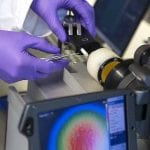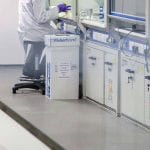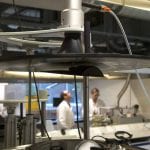The quest continues

Chris Proctor
BAT’s Chris Proctor shares his views on the current state and future direction of tobacco research.
By George Gay
In recent years, British American Tobacco (BAT) has invested a huge amount of money in increasingly advanced scientific research into tobacco products and, more latterly, alternative products. Firstly, it concentrated on investigating whether tobacco cigarettes could be modified so as to make their consumption significantly and demonstrably less risky than is the consumption of unmodified products. And then it moved the focus of its attention toward vapor products, which deliver nicotine without the compounds generated by burning tobacco.
Partly because they have found acceptance with many smokers and former smokers, these vapor products seem to offer a public health advantage that is immediately realizable and far higher than could be expected from any combustible cigarette, no matter how skillfully it were modified.
The question seems to arise, therefore, as to whether there is any point in continuing with research into combustible products. And after running into BAT’s chief scientific officer and head of scientific product stewardship, Chris Proctor, at the Global Forum on Nicotine in Warsaw, Poland, in June, Tobacco Reporter had the opportunity of posing, in an email exchange, a number of questions about the current state and direction of travel of tobacco research.
Tobacco Reporter: Is BAT still involved in research and development in respect of traditional tobacco cigarettes.
Chris Proctor: Yes. While it may not be possible to measurably reduce the inherent risks of cigarette smoking, we are still involved in research in respect of traditional tobacco products. Cigarettes are the most common way of consuming tobacco, and while the health risks of using tobacco are well-known, it remains important to apply sound product stewardship principles to ingredients used in cigarettes to make sure they do not add to the inherent risks of smoking. Through our research we aim to increase the scientific understanding of the harm caused by the use of tobacco and nicotine products and seek to apply this knowledge to the development and testing of potentially reduced-risk products.
Would you please describe the sorts of research that you are carrying out in respect of traditional tobacco products?
We have several research programs ongoing at our facilities in Southampton and Cambridge in the U.K. We have for many years worked on identifying the toxic constituents of tobacco smoke and understanding how they are formed and whether they can be reduced. We also conduct studies aimed at how people use their products, studies aimed at understanding the development of disease and studies of the tobacco plant itself.
Smoke chemistry and dosimetry: We have for many years studied the complex chemistry of cigarette smoke. We are now studying how the aerosol properties of tobacco smoke—the size, concentration and chemical composition—impact on how and where smoke is deposited in the lungs and how its component chemicals are then delivered systemically. By understanding what people are exposed to, we can start to better understand the disease process.
In vitro testing: We are currently investigating a range of specific lab-based disease models relevant to a number of tobacco-related diseases. The aim is to develop physiologically relevant screening tools that will help us to understand and investigate the mechanisms of cigarette smoke toxicity as well as to identify and assess disease-related biomarkers. These tests can be used to determine whether a change in cigarette smoke composition results in a change in the response of one or more of these models. Some of these models could form part of a framework for testing next-generation products.
Tobacco genomics: Many of the toxicants in cigarette smoke have their origins in the cellular structure of the tobacco plant or might be affected by processes in the plant during growing or curing, for example. Understanding the genes involved may help develop new plants that result in lower toxicants both in the tobacco and in cigarette smoke. We have a very active biotechnology program working on this.
Is some research having to be directed at addressing issues arising from the introduction of new regulations, such as those to do with restrictions on the use of flavors and additives, or are such issues addressed mainly through leaf tobacco research?
Some of the research is focused on being responsive to developing regulations. For example, in the EU there are requests from the regulators for more scientific information on certain ingredients added to cigarettes.
Not long ago, BAT was heavily involved in research aimed at developing traditional tobacco cigarettes that could be shown to be less risky than were mainstream products. Is this work still in progress?
We developed a number of technologies, which when used in combination were found to significantly reduce the levels of certain smoke toxicants in cigarette smoke. We published the results of clinical studies that showed that there was a corresponding reduction in smokers’ exposure to these toxicants. We were unable to demonstrate that this reduction in exposure had a biologically relevant effect.
This finding led us to accelerate our work on alternative tobacco and nicotine products such as e-cigarettes. However, we have maintained some effort on new technologies that could help reduce cigarette smoke toxicants.
Would it be true to say that most of BAT’s product research is now focusing on noncombustible tobacco products and, especially, on nicotine-delivery devices?
The renaissance in product innovation away from traditional combustible cigarettes has certainly seen a boom in research on next-generation products and the emergence of some very new technology. We are constantly looking at ways of improving our existing products and developing new concepts. We have several products in our pipeline, including medicinal nicotine products, e-cigarettes, tobacco-heating products and hybrid products.
In addition to developing these new technologies, we also develop methods and tests to help ensure that products based on new technologies are as safe as they can be. Our research led to the development of a scientific framework that can be used to assess the reduced-risk potential of innovative nicotine and tobacco products.
This framework employs a four-stage process that uses lab-based and clinical tests along with real-world observations of individual and population perception and use. The first step is understanding how consumers use the products and using this information to then understand the products. This is followed by clinical testing to determine that these products produce and deliver fewer toxicants than conventional cigarettes. Then the testing moves into the real-world use to determine what impact, if any, this reduction in toxicants will have on a person’s individual risk and also on the collective risk of the population using the products.
What are the most exciting areas of research in respect of noncombustible tobacco products and nicotine delivery devices?
Perhaps the most exciting, and most challenging, is our research into characterizing the potential health risks of the emerging technologies. Here we are investing significantly in the toxicological sciences, and in particular in vitro models of disease.
What other areas of research is BAT pursuing?
One thing that we are working particularly hard on is developing scientific approaches to “bridge” from one data set to another. When technologies are evolving so rapidly, it is necessary to find ways in which, for example, the scientific package of data on a generation-two e-cigarette can be applied to a generation-three device without having to repeat all of the key studies.
Is there a level of frustration among scientists researching in the field of tobacco harm reduction because some are having to repeat badly conducted studies that give a false picture of less risky products?
I think all researchers have a duty to conduct their research with openness and transparency and that the research should be grounded in a practical application. Unrealistic experimental conditions can produce results that would not be expected under more realistic conditions. But it is also up to the industry to publish widely so that independent scientists can look at all the science generated and make decisions on what is real and what is not.
Having seen you speak during a transparency debate at the 2016 Global Forum on Nicotine [GFN] in Warsaw, Poland, in June, I am aware that you are somewhat frustrated at various aspects of the publication of scientific papers. This is of particular concern, I suppose, when the science is aimed at reducing the harm caused by tobacco. Do you think you are making progress?
As I said at the GFN, I believe we need more transparency, not less, in scientific research. Next-generation products like e-cigarettes have the potential to save millions of lives, and this potential must not be lost in a zeal that sees a desire to eliminate tobacco-related disease confused with a desire to eliminate an industry. These products are new and changing rapidly, and regulators and the public alike should have as much information available to them as possible. We need to be able to trust the science. Making the science available for review and critique is essential. Being able to publish that science is the only way to do this. Having said that, there are only a handful of journals with a policy not to process any papers based on research funded by the tobacco industry. But no science should be censored.









